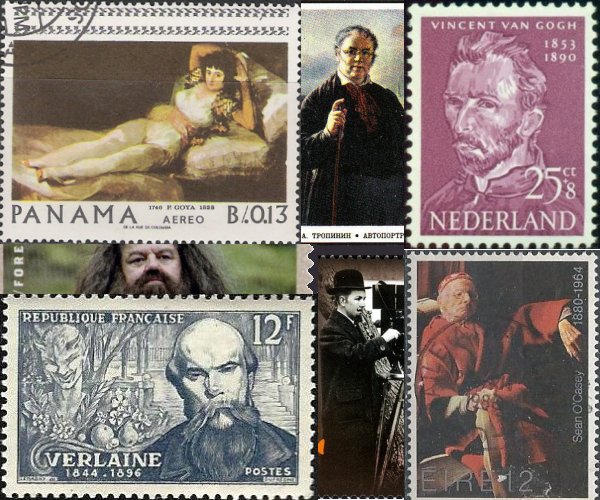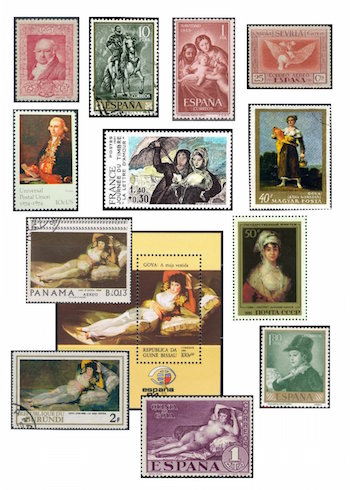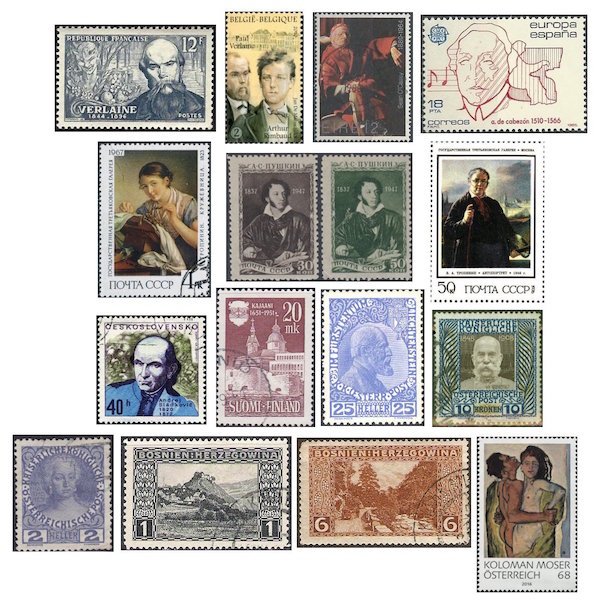The Arts on the Stamps of the World — March 30
An Arts Fuse regular feature: the arts on stamps of the world.

By Doug Briscoe
Two of the world’s greatest painters share this March 30 birthday, Francisco Goya and Vincent van Gogh. We also salute Paul Verlaine, Seán O’Casey, and Spanish Renaissance composer Antonio de Cabezón along with eight other artists and give a nod—or three nods—to Warren Beatty, Eric Clapton, and Robbie Coltrane.

We can only begin to do justice to the splendor of Francisco de Goya (30 March 1746 – 16 April 1828) and Vincent van Gogh (30 March 1853 – 29 July 1890) by presenting substantial samples of their work as seen on stamps from all over the world. Yes, this is a sampling only, with many more than these in existence. Goya’s native Spain, as you might expect, has done him greater philatelic service than other nations, beginning with the four at the top. In the next row we see that even the United States has released a stamp of a Goya painting, this as part of a set from 1974 celebrating the Universal Postal Union and encouraging letter writing. Next to that one are examples from France and Hungary. We continue with a salute to the immortal Maja, both vestida and desnuda. The Russian stamp shows Portrait of the Actress Antonia Zárate (c1810-11), which hangs in the Hermitage in Saint Petersburg, and the last item, from a set of ten Goya stamps, is a charming portrait of his son Mariano.
Having devoted a page to Goya, we can hardly do less for van Gogh, and where better to begin than with an array of his striking self-portraits? Flowers must come next, and we’ve reserved Starry Night for the third row.

A great artist whose lifespan corresponded closely with van Gogh’s was the French poet Paul Verlaine (1844 – 8 January 1896), whose work has been set to music by Fauré, Debussy, Ravel, Reynaldo Hahn, Koechlin, Stravinsky, Britten, and many others. I know of two Verlaine stamps, even if on the Belgian one he takes a bit of a back seat to Rimbaud, with whom he enjoyed (?) a stormy relationship. You can see all about it in the 1995 semi-historical film Total Eclipse with David Thewlis as a bedeviled Verlaine and a ravishing Leonardo DiCaprio as the ravishing and insufferable Rimbaud.
Irish playwright Seán O’Casey (Seán Ó Cathasaigh for purists) was born John Casey on this day in 1880. His eyesight was so poor in childhood that he wasn’t able to teach himself to read and write until mid-childhood (one source says age 10, another 13). John and his brother began putting on dramatic performances of Shakespeare and Irish playwright Dion Boucicault in the home. He turned to Irish nationalism, a theme that is at the center of his first three produced plays, The Shadow of a Gunman (1923), Juno and the Paycock (1924), and The Plough and the Stars (1926). Alfred Hitchcock made a film of Juno in 1930, and Marc Blitzstein turned it into a musical in 1959. O’Casey continued to ruffle feathers with his daring plays, but enjoyed the support of such figures as W.B. Yeats, G.B. Shaw, and Charles Laughton. He lived in Britain, mostly London and Totnes, until his death on 18 September 1964.
At this point we revert to chronology and begin with the Renaissance Spanish composer Antonio de Cabezón, born on this day in 1510. He was an organist, blind from childhood, and served Queen Isabella at the royal and, later, imperial court of Charles V. Curious how so many organist-composers were blind: Louis Vierne, Jean Langlais, John Stanley, Helmut Walcha, Gaston Litaize, and others, including Bach, who went blind at the end of his life. There’s a doctoral thesis for you. Only a single vocal work by Cabezón survives; all the rest is instrumental music centering on liturgical organ pieces and tientos and variations for keyboard. He died four days before his 56th birthday on 26 March 1566.
Russian painter Vasily Tropinin (March 30 [O.S. March 19] 1776 – May 16 [O.S. May 4] 1857) was born into serfdom and didn’t attain freedom until he was nearly fifty. His master sent him to Saint Petersburg to learn confectionery, and Tropinin took the free drawing lessons at the Imperial Academy of Arts instead. Apparently the master was not disapproving and allowed the tuition to continue, but Tropinin was not manumitted for another quarter century. In that year, 1823, he painted one of his most well known works, The Lace Maker, and four years after that produced his most famous work, a portrait of Pushkin, seen on a pair of Soviet stamps honoring the poet in 1947. The self-portrait showing a rather refined and scholarly looking gentleman was made in 1846.
Slovak poet Andrej Sládkovič (30 March 1820 – 20 April 1872) was born Andrej Braxatoris. His father was also a writer. Andrej studied theology and became a pastor, publishing his first poems at age 22. A supporter of the Revolution of 1848, he took a rather humanist stance in his poetry, which also reflects the influence of Slovak folklore and a love of nature. Sládkovič also worked as a critic and translated Voltaire and Racine.
Multitalented Finnish architect Johan Jacob Ahrenberg (1847, Vyborg – 10 October 1914) is not himself honored on a stamp, and his work is only incidentally seen on one issued for the 300th anniversary of the founding of the city of Kajaani. The spire at left, Kajaani Church (1896), is Ahrenberg’s work. He not only built a number of other structures in Finland, but also painted, designed furniture and textiles, wrote novels and stories (in Swedish), and composed a six-volume memoir in which he describes his personal relationships with Turgenev, Heinrich Schliemann, and Viktor Rydberg!

The Austrian Koloman Moser (1868 – 18 October 1918) was another of those artists who worked in multiple media: book illustrations, stained glass, textiles, porcelain, jewelry, furniture, and more. A representative of the Jugendstil, he was a member of the Vienna Secession movement and with colleague Josef Hoffman founded Wiener Werkstätte, a sort of factory for visual arts, in 1903. Among his many avenues of creativity was the design of postage stamps, including the first stamps issued by Liechtenstein. We see one of those next to the Finnish stamp and a few examples from Austria and Bosnia from the years 1908 et seq. More than a century later, just last year, to be precise, Austria saluted Moser with one of his more daring canvases, Lovers from c1913, the juxtaposition of which to the Bosnian and older Austrian issues may strike you as slightly incongruous.
Another stamp designer and a most interesting case from the philatelic angle is Edmund Blampied (30 March 1886 – 26 August 1966), an artist who was trapped on his native Jersey when the Germans occupied the Channel Islands at the outset of World War II. They asked him to design a set of postage stamps for the island, and he complied, but hid the initials GR (“George Rex”) in one of the designs to signify loyalty to George VI. He similarly worked a “V” for victory into his design of a new sixpence note in 1942. I show what we collectors call a “cover” that is, a complete envelope, in this case, one that actually went through the island’s postal service in 1943, showing four of the six stamp designs, with the subversive three pence value and its secret message superimposed. After the war he designed a stamp for the third anniversary of the liberation of Jersey (at center) and the island’s first stamp when the bailiwick began to issue its own postage in 1964 (the Elizabeth II stamp next to it). Since his death Jersey has issued several stamps showing Blampied’s other art work.
The Estonian photographer and filmmaker Johannes Pääsuke (30 March [O.S. 18 March] 1892 – 8 January 1918 [O.S. 27 December 1917]) loved photography from an early age and after studying the subject began to work for the Estonian National Museum, documenting the landscape, architecture, and people of the region. More than 300 of his photographs from this period survive. From this he turned to film, indeed is credited with being the first Estonian filmmaker. All but one of his forty films are newsreels and documentaries. The exception is Bear Hunt in Pärnu (1914), the first Estonian narrative film. Pääsuke served in World War I (he had a very boyish appearance and in his uniform looks about 13 when he was in fact ten years older) and survived the war only to be killed in a train accident at 25.
French author Jean Giono (30 March 1895 – 8 October 1970) was also called up to serve in World War I, and his experiences made of him a lifelong pacifist. He worked at a bank before and after the war and quit only with the success of his first novel Colline (1929). Giono set most of his fiction in Provence, and Marcel Pagnol made three films of the early novels Un de Baumugnes (Lovers are Never Losers, 1929, filmed as Angèle in 1934); Second Harvest (1930, as Regain, 1937); and Jean le Bleu (Blue Boy, 1932, made into La Femme du boulanger in 1938). Any number of Giono’s stories have been translated to the screen, one of them, Le Hussard sur le toit (The Horseman on the Roof, 1951) with Juliette Binoche in 1995, and another, Les Âmes fortes (Savage Souls, 1949) in 2001.

It’s appropriate that our final painter today should be the Georgian Lado Gudiashvili (gu-dyahsh-VEE-lee; March 18, 1896 – July 20, 1980), as a connection with Goya can be made; some of his works echo pieces like Saturn Devouring His Son with their portrayal of monsters, ruins, naked mythological deities, and death. He was even called the “Georgian Goya” by some. Much of Gudiashvili’s other work, though, is decidedly more benign, like Collecting Tea of 1964 (shown). He studied in Tiflis (Tbilisi) and Paris, where he met Modigliani and others. Much later, his grand painting of Kashveti Church got him fired from his twenty-year teaching post at the Tbilisi academy. Keenly interested in theater, Gudiashvili worked in stage decoration and in film and as a book illustrator.
Happy birthday to Warren Beatty (né Beaty; born March 30, 1937), Eric Clapton (1945), and Robbie Coltrane (born Anthony Robert McMillan on 30 March 1950), who gets his stamp (an American one!) for his portrayal of Hagrid in the Harry Potter film series.
A graduate of the University of Massachusetts with a B.A. in English, Doug Briscoe worked in Boston classical music radio, at WCRB, WGBH, and WBUR, for about 25 years, beginning in 1977. He has the curious distinction of having succeeded Robert J. Lurtsema twice, first as host of WGBH’s weekday morning classical music program in 1993, then as host of the weekend program when Robert J.’s health failed in 2000. Doug also wrote liner notes for several of the late Gunther Schuller’s GM Recordings releases as well as program notes for the Boston Classical Orchestra. For the past few years he’s been posting a Facebook “blog” of classical music on stamps of the world, which has now been expanded to encompass all the arts for The Arts Fuse.
